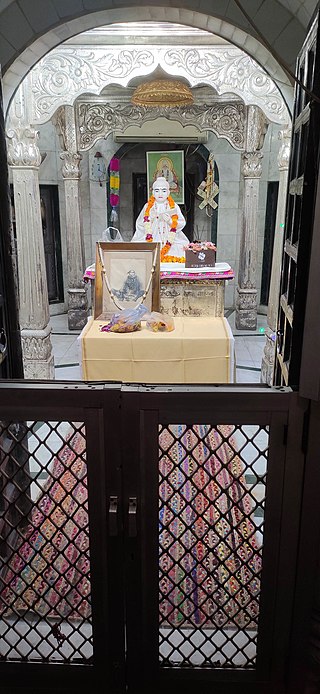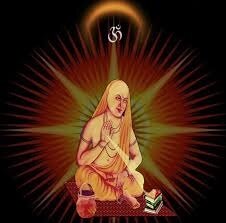
Dharamdas was an Indian saint, Bhojpuri language poet and one of the disciples of Kabir. [1] [2] [3] It is said that after becoming Kabir's disciple, he gave away all his rich possessions. [4]

Dharamdas was an Indian saint, Bhojpuri language poet and one of the disciples of Kabir. [1] [2] [3] It is said that after becoming Kabir's disciple, he gave away all his rich possessions. [4]
Dharamdas was born into a rich Vaishya family near Jabalpur of Madhya Pradesh. [5] Dharamdas made two gurus in his life: the first Guru was Roopdas and the second Guru was Kabir. [6] The name of Dharamdas' wife was Amini Devi. He had two sons, the first son was Narayan Das who opposed Kabir's knowledge and the second son was Chudamani (Muktamani).
Since childhood, he was very religious. He used to like attending Satsang, Puja, pilgrimages, etc. Earlier, he used to worship idols.One day he met with Kabir. [7] Both discussed spiritual knowledge. In the first meeting, he did not accept the spiritual knowledge that was given by Kabir. But after he understood the spiritual knowledge from Kabir, he left idols' worship. [8] After giving initiation to Dharamdas, Kabir Saheb took him to the Satlok (Immortal place). After coming from satlok, he wrote Kabir Sagar, Kabir Beejak, and Kabir Sakhi which were narrated by Kabir.
Aaj mohe darshan diyo ji Kabir ||tek|| Satyalok se chal kar aaye, kaatan jam ki janjeer ||1|| [9] Thaare darshan se mhaare paap katat hain, nirmal hovae ji shareer ||2|| Amrit bhojan mhaare Satguru jeemaen, shabd doodh ki kheer ||3|| Hindu ke tum Dev kahaaye, Musalmaan ke peer ||4|| Dono deen ka jhagda chhid gayaa, tohe na paaye shareer || 5|| Dharmdas ki arj Gosaain, beda lagaaio parle teer ||6||
After the founding of Kabir Chaura by Kabir's disciple Surat Gopal, whom was the first Kabirpanthi missionary, Dharamdas would slightly later found the Dham Khera (Damakheda) maṭh (also known as māī meaning "mother) located in modern-day Chhattisgarh. [10] It conducted missionary activities in central India and had branches located in Raipur, Bilaspur, and Chindawara. [10]

Kabir was a well-known Indian mystic poet and sant. His verses are found in Sikhism's scripture Guru Granth Sahib, the Satguru Granth Sahib of Saint Garib Das, and Kabir Sagar of Dharamdas. Today, Kabir is an important figure in Hinduism, Sikhism and Islam, especially in Sufism.
Satguru, or sadguru, means the 'true guru' in Sanskrit. The term is distinguished from other forms of gurus, such as musical instructors, scriptural teachers, parents, and so on. A satguru has some special characteristics that are not found in any other types of spiritual guru. Satguru is a title given specifically only to an enlightened rishi or sant whose life's purpose is to guide the initiated shishya on the spiritual path, the summation of which is the realization of the Self through realization of God.
Contemporary Sant Mat Movements, mostly among the Radha Soami tradition, are esoteric philosophy movements active in the United States, Europe, Australia, Latin America, and especially India. These movements assert that Sant Mat shares a lineage with Sikhism and contains elements of thought found in Hinduism, such as karma and reincarnation. They further assert that Sant Mat also contains elements found in Sufism and has inspired and influenced a number of religious groups and organizations. They refer to this spiritual path as the "Science of the Soul" or 'Sant Mat', meaning 'teachings of the saints'. More recently it has been described as "The Way of Life" or "Living the Life of Soul". It incorporates a practical yoga system known as Surat Shabd Yoga.
Surat Shabd Simran is a type of spiritual meditation in the Sant Mat tradition.

Radha Soami is a spiritual tradition or faith founded by Shiv Dayal Singh in 1861 on Basant Panchami Day in Agra, India.
Sampradaya, in Indian origin religions, namely Hinduism, Buddhism, Jainism, and Sikhism, can be translated as 'tradition', 'spiritual lineage', 'sect', or 'religious system'. To ensure continuity and transmission of dharma, various sampradayas have the Guru-shishya parampara in which parampara or lineage of successive gurus (masters) and shishyas (disciples) serves as a spiritual channel and provides a reliable network of relationships that lends stability to a religious identity. Shramana is vedic term for seeker or shishya. Identification with and followership of sampradayas is not static, as sampradayas allows flexibility where one can leave one sampradaya and enter another or practice religious syncretism by simultaneously following more than one sampradaya. Samparda is a punjabi language term, used in Sikhism, for sampradayas.

Shiv Dayal Singh, known by the honorific "Param Purush Puran Dhani Huzur Soami Ji Maharaj" by his disciples and devotees, was an Indian spiritual guru and founder of Radha Soami, a 19th-century spiritual sect.
Sant Mat was a spiritual movement on the Indian subcontinent during the 13th–17th centuries CE. The name literally means "teachings of sants", i.e. mystic Hindu saints. Through association and seeking truth by following sants and their teachings, a movement was formed. Theologically, the teachings are distinguished by inward, loving devotion by the individual soul (atma) to the Divine Principal God (Parmatma). Socially, they are mostly ascetics except few householders. Sant Mat is not to be confused with the 19th-century Radha Soami, also known as contemporary "Sant Mat movement".

Kabir Panth is a Sant Mat denomination and philosophy based on the teachings of the 15th century saint and poet, Kabir. It is based on devotion to him as one guru as a means to salvation.The adherents of Kabir Panth are from many religious backgrounds as Kabir never advocated change of religions but highlighted their limitations. According to some scholars, this tradition belong to Vaishnavism with universalist leanings. In respect of Kabir, his followers celebrate Kabir Jayanti.

Bhagat Sadhna, also called Sadhna Qasai, was a north Indian poet, saint, mystic and one of the devotees whose hymn was incorporated in Guru Granth Sahib. Venerated in the region of Punjab, among Sikhs and Ravidassias, his devotional hymn is widely quoted by most preachers. His one hymn is present in Adi Granth Sahib, in Raga Bilaval.

Advait Mat or Paramhans Advait Mat is a cluster of panths in northern India. It was founded by Shri Swami Advaitanand Ji Maharaj (1846–1919) who is also known as Paramhans Dyal Ji Maharaj. He declared Swami Swarupanand Ji Maharaj as his spiritual successor. Swami Swarupanand Ji Maharaj founded more than 300 ashrams with the purpose of disseminating his master's teachings. Swami Swarupanand Ji Maharaj had initiated more than thousand of his disciples into the sanyas. Many of his disciples went on to establish spiritual institutions to spread the same knowledge.

Ajaib Singh, also known to his disciples as 'Sant Ji' was born on September 11, 1926, in Maina (Mehna), Bhatinda district, Punjab, India.

Ravidas or Raidas (1267–1335) was an Indian mystic poet-saint of the Bhakti movement during the 15th to 16th century CE. Venerated as a guru in the modern regions of Uttar Pradesh, Bihar, Rajasthan, Gujarat, Maharashtra, Madhya Pradesh, Punjab, and Haryana, he was a poet, social reformer and spiritual figure.

Shiv Brat Lal Verman, (1860-1939) popularly known by the honorifics "Data Dayal" (Merciful) and "Maharishi", was born in Bhadohi district of Uttar Pradesh state in India in February 1860. He was a post graduate and a famous writer. It is believed that he wrote as many as 3,000 books on various social, historical, religious and spiritual topics. Being a famous writer he was called as the modern Maharishi Ved Vyas and hence became famous with the name Maharishi ji.

Saint Garibdas Ji Maharaj was a spiritual leader and reformer. He took birth in 1717 A.D. to a family of Dhankhar jats in the village Chudani, District Jhajjar, Haryana, India. He was a rich farmer. According to his own account, his spiritual journey started when "Almighty God" Kabir came to meet him and gave him initiation at the age of 10 years. After getting spiritual awareness from "Almighty God Kabir", he uttered many Banis that are collected as holy book Garib Das ki Granth. Garibdas Panth is also a Kabirpanth. Saint Garib Das Ji told through his Banis that Kabir Sahib is the supreme God in Satlok. Garibdas died in 1778 A.D., and over his remains, a memorial was established.

Ram Charan (1720–1799)) is the Rajasthani Hindu guru, inspirator of a religious tradition called Ramsnehi Sampradaya or Ramdwara. He initiated and illustrated Nirguna (absolute) Bhakti, although he was not against Saguna Bhakti. He initiated and tried to eliminate "show", blind faith, hypocrisy and misled existing in the Hindu religion and preferred to worship the 'name of God', Rama, over God, to not get involved in false "show" activities.

Baba Faqir Chand, was an Indian master of Surat Shabd Yoga, or consciously controlled near death experience. He was one of the first saints or gurus of Sant Mat tradition to openly speak and write against the deceptive and harmful practices of modern guruism and religious intolerance. As a highly pragmatic individual, Faqir also strove to explain the various practices and principles of Sant Mat based on his own experiences and in the context of modern science and psychology. He was also the first Sant Mat guru to talk about the phenomena consisting of a believer experiencing a subjective projection of a sacred or holy form of a guru or idol without the conscious knowledge of the person at the center of the experience, i.e., the guru. This was termed the 'Chandian Effect', and described by researcher David C. Lane. Faqir Chand claimed that he had no knowledge of his form manifesting before a person and helping them with their worldly or spiritual problems. He fervently expressed that in his experience, the real helper is one's own true self and faith. Mark Juergensmeyer, another researcher on new religious movements, intrigued by the uniqueness of Faqir Chand's experiences, also interviewed him. This insightful interview was included in Faqir's autobiography.
Baba Devi Sahab (1841–1919) was one of the leaders of the Sant Mat religious movement, popularizing it throughout North India and Pakistan.
Bhojpuri literature includes literature written in Bhojpuri language. Bhojpuri has developed over a course of 1300 years, the development of the language started in 7th century. The earliest form of Bhojpuri can be seen in the writings of Siddha Saints and Charyapada. Distinct literary traditions in Bhojpuri language date back to medieval periods when saints and bhakts of the region adapted a mixed language for their works.

Nabha Dass, born as Narayan Dass, was a Hindu saint, theologian and author of the Bhaktamal. In this sacred scripture, Nabha Das wrote the life history of almost every saint ranging from the Satya Yuga to the Kali Yuga age. Nabha Dass wrote ‘Bhakatmal’ in 1585. Nabha Dass, a saint belonging to the tradition of Ramananda. On his birthday 8 April, millions of followers remember him and his resolve to work for humanity.